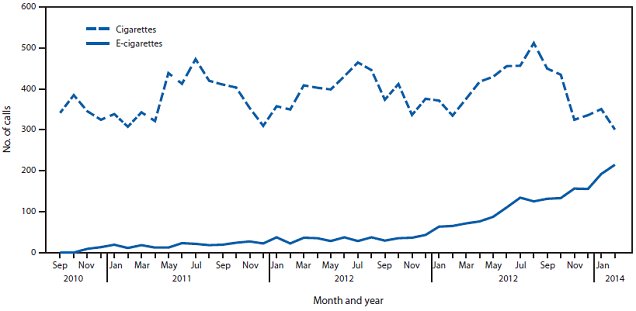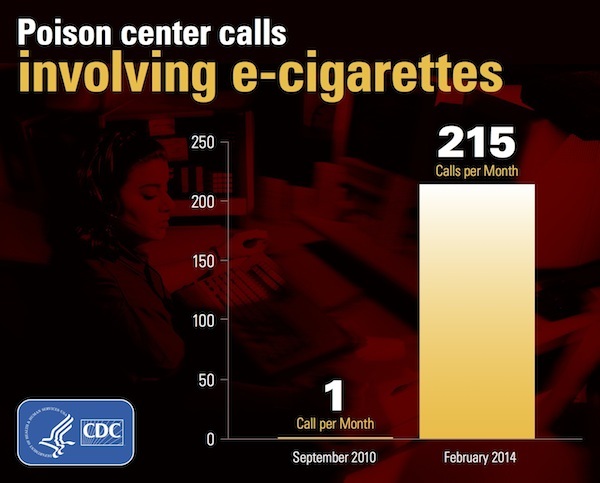
The CDC doesn’t have the best track record when it comes to researching e-cigarettes. After kicking up a big fuss about e-cig use by teens (the majority of whom were smokers) increasing, they’ve opted to focus on the e-liquid poisonings issue in a new study. Following the “Poison by the Barrel” article by the New York Times – which was a fear-mongering hunk of verbal diarrhea – the CDC is reporting that the number of calls to poison control centers relating to e-cigarettes increased from one per month in September 2010 to 215 per month in February 2014.
That’s a big increase, definitely, and the media has repeated the results with all the predictable stupidity of a fly repeatedly banging itself into a window. As usual, there is a much more complicated reality hiding behind these figures, and not only has there been a dearth of cogent analysis of what was found, the drastically bigger number of cigarette poisonings has been roundly ignored. CDC Director Tom Frieden commented that, “e-cigarette liquids as currently sold are a threat to small children,” but clearly saw no cause to point out that the research shows that tobacco cigarettes are a significantly greater threat.
Summary
- Research looked at the numbers of e-cigarette and cigarette-related calls to nationwide poison control centers between September 2010 and February 2014.
- In total, there were 2,405 e-cigarette-related calls and 16,248 relating to cigarettes.
- E-cigarette calls increased from 1 per month in September 2010 to 215 per month in February 2014, and cigarette-related calls ranged from 301 to 512 per month.
- 42 percent of e-cigarette calls were relating to over 20s – over 12 times as many children aged 0 to 5 were poisoned by cigarettes compared to e-cigarettes.
- Out of the calls reporting adverse events, 57.8 percent of e-cigarette calls had adverse events, but only 36 percent of cigarette-related ones. The most common symptoms of e-cig events were nausea, vomiting and eye irritation.
- The number of calls relating to e-cigarette use was undeniably related to the increase in their usage over the same time period, and particularly the increase in usage of refillable models.
- It’s essential to exercise caution in the storage and usage of e-liquid – it is a poison and should be treated as such. Keep it well out of reach of children and pets.
What They Did – Comparing E-Cig and Cigarette Poisonings
The basic aim of the new piece of research was to determine how regularly nationwide poison control centers received calls relating to e-cigarettes, and they offer corresponding figures for cigarettes to enable comparison. The start of the study period was September 2010, when new codes were added to log e-cigarette related calls, and it ran through until February 2014. An e-cigarette exposure could have been related to the liquid or the devices, and cigarette exposures excluded cases involving butts only or ones with multiple substances (cigarettes and alcohol, for example).
What They Found – Increase in E-Liquid Poisonings, But More Cigarette Poisonings

Over the study period, there were 2,405 exposures to e-cigarettes and 16,248 exposures to cigarettes, meaning that around 6.76 times more people were poisoned by cigarettes. The full results show that – along with the headline finding of an increase from 1 to 215 e-cigarette exposure calls per month – there were between 301 to 512 calls per month about cigarette poisonings. In September 2010, e-cigarette poisonings accounted for 0.3 percent of the combined cigarette and e-cigarette poisoning calls, and in February 2014 this had increased to 41.7 percent.

There were several other findings about the characteristics of these calls. More of the e-cigarette calls came from health care facilities, and e-cigarette poisonings were more likely to be through inhalation, eye or skin exposure but less likely to be ingested (97.8 percent of cigarette exposures and 68.9 percent of e-cigarettes exposures). An interesting addition – especially given the “think of the children” rallying call cropping up from Tom Frieden – is that 94.9 percent of cigarette-related calls concerned children aged 0 – 5 years, compared to only 51.1 percent of e-cigarette calls, with 42 percent of them relating to over 20s. A simple bit of math tells you that over the study period, e-cigarettes potentially poisoned 1,229 children under five, but cigarettes potentially poisoned 15,419. So, there were actually over 12 times as many poisoning calls related to cigarettes for under fives than for e-cigarettes.
One important point, however, is that out of the calls with information about adverse health effects, e-cigarette calls were more likely to be associated with side effects. 57.8 percent of e-cig calls noted adverse effects, compared to 36 percent of the cigarette ones. This is clearly related to the nature of e-liquid (you can be exposed by spilling it on your skin as well as ingesting it, and it’s fairly concentrated), but is not a positive finding, regardless. However, it must be added that nausea, vomiting and eye irritation were the most common side effects. Only one person died from e-cigarette liquid, and that was somebody who intravenously injected it as a method of committing suicide.
Is E-Cigarette Liquid Poisoning Something to Worry About?

The study is destined to become a justification for critique of e-cigarettes or even calls for e-liquid bans, but there is much more to this finding than it seems. Firstly, the results of exposure to e-cigarettes (and likely to cigarettes too) were ordinarily minor, and in fact the only severe consequence noted was the suicide attempt. This is in line with other research looking at e-cig poison control center calls from California, which found that out of 35 cases between 2010 and 2012, only five went to the emergency department and all were sent back home within four hours (as reported in a recent systematic review of the safety of e-cigarettes). Just because someone calls the poison control center doesn’t mean there’s a serious poisoning.
An additional problem is pretty obvious: more people are using e-cigarettes, so it’s expected that there would be a larger raw number of poisonings. In the same way, there were fewer car accidents when fewer people had cars. In 2010, there was around $82 million worth of e-cigarette sales (according to UBS, Wells Fargo and TVECA data), and it had increased to around $1.7 billion in 2013. So it’s hardly surprising that there would be an increase in poisonings, particularly given that refillable e-cigarettes are likely to be much more popular among vapers today than in 2010. It’d be pretty difficult to be exposed to e-liquid through a closed cartridge, so with more e-liquid bottles sitting around it’s probable that a larger proportion of e-cig users will have been involved in a poisoning in 2014 too. It would be interesting to compare numbers of refillable e-cig users with poisoning reports for that reason – it’s not such a leap of faith to assume a concurrent increase.
That all said; it’s undeniable that e-liquid is poisonous and we should exercise caution about how we handle and store it. If you don’t want your child or pet to get hold of your e-liquid, keep it in a safe place and well out of reach. Child-proof caps help, but don’t rely on them. There’s more about this in our guide to e-cig safety.
However, the problem with demonizing e-cigarettes is that there are a wide variety of products in almost anyone’s house with the potential to poison kids or pets that swallow them, including (but in no way limited to) cleaning products, cosmetics and pharmaceuticals. Dr. Konstantinos Farsalinos puts forward this argument in response to a similar finding from Sweden, and it’s of the utmost importance when thinking about whether e-liquid is anything uniquely dangerous. We keep a ton of dangerous things in our house, and we avoid exposing children by making sure they can’t get hold of them.
But – some argue – e-liquid comes in appealing flavors, bleach does not. This is a fair point in terms of smell, but undeniable nonsense when it comes to taste. If you’ve ever accidently got a drop of e-liquid in your mouth, I’m confident that you would never, ever drink it on purpose. It tastes powerfully bitter, with a sharp, pungent kick that makes you rinse your mouth out if you consume so much as the tiniest taste. Words can hardly describe how disgusting it is. I’ve never tasted bleach, but I can’t imagine it being much worse. Needless to say, a child may think it’s a good idea to drink some, but the vast majority will be quickly put off that idea. This is probably why there were no really severe symptoms outside of the initial nausea and vomiting, as well as eye irritation (which tends to happen when something gets in your eye), because nobody was stupid enough to drink a lot of it.
Conclusion
Despite the frenzy the media is going into about e-liquid poisonings, the research doesn’t really show much cause for concern. If you want to avoid accidental poisoning of children, as Tom Frieden claims to, it would make considerably more sense (12.5 times more sense, to be precise) to worry about young children eating tobacco cigarettes. Caution is vital when storing and handling e-liquid, but pretending it’s even a significant risk among our existing household poisons is an absolute absurdity. This problem would be well illustrated to the public if the cigarette poisoning calls from the study were also highlighted in reporting, but somewhat unsurprisingly, the go-to-message is that e-cigarettes should be public enemy number one.

